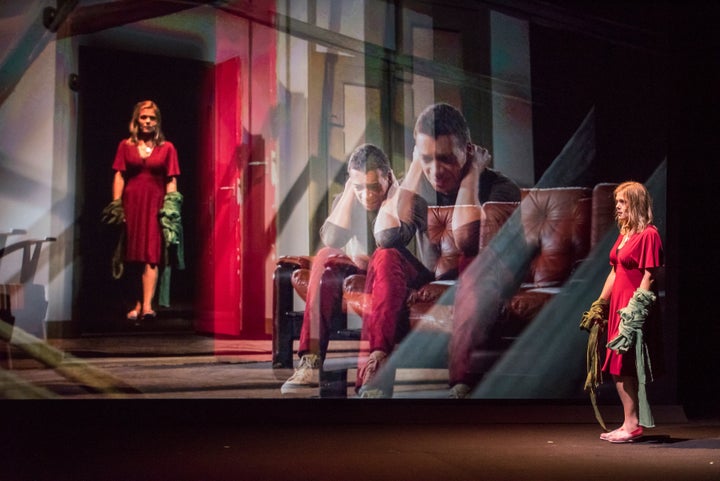
Miah Persson and Roderick Williams (film) in Blank Out at Park Avenue Armory.
Memory in traumatic loss illustrates the paradoxes and complexities of the human mind— fragmented yet precise, clear yet dreamlike, intrusive yet elusive. The Dutch composer Michel van der Aa has masterfully captured the complex elements of memory, loss, and identity in the U.S. premiere of his chamber opera Blank Out in the soaring cavernous space of the Park Avenue Armory Drill Hall. The chamber opera is based on the life and work of South African poet Ingrid Jonker, who committed suicide by drowning in 1965 at the age of 31.
The opening scene begins simply on a sparse stage with a reel-to-reel tape deck and a blank screen. Swedish soprano Miah Persson plays the Woman, who pieces together the moment her son died in a drowning accident, singing fragmented phrases facing the side of the stage. The expressive words do not make sense at first, their meaning enigmatic. Her perfect timing and pacing become apparent a few moments later when a recorded version of her live performance is projected in 3-D film behind her; her image faces the audience. The first loop plays onscreen, and Persson accompanies the image of herself, filling in the gaps. This process is repeated yet again, so there are now three women, each conveying with powerful urgency the critical, paralyzing moment her son drowns. Her memory builds on itself, emerging like shadows on a photo developing in the dark room.
As she wistfully recalls moments of her son’s childhood, she faithfully builds the interior of a replica home the size of a miniature dollhouse. She adjusts a programmed video camera so that it zooms in on the model furniture and projects onscreen a life-size version of the living room, creating a dreamlike, streamlined model of reality. Her need to reconstruct the physical details of the home appears obsessive at times and forensic, as if she were trying to prove to herself that the past occurred just so. Her compulsion to revisit this is familiar to those who have experienced or seen the grief of traumatic loss.
As a psychiatrist, I have witnessed memory in traumatic loss, through the heartbreaking stories of parents who have lost children, children who have lost parents. Fragments of memories— a photographic snapshot of a hand or smell or sound of a voice— inevitably resurface at the most unexpected times, along with an urgent need to place these pieces into a coherent narrative. The compulsion to revisit and recreate memories of these final moments (”I repeat you/ without beginning or end” goes the libretto) lives at the borders of necessity, yearning, and healing— a wish to understand or contextualize the meaning of an experience that cannot be fully grasped. As Dr. Bessel Van der Kolk, a prominent psychiatrist and expert on trauma, described in his 1998 paper Trauma and Memory:
People seem to be unable to accept experiences that have no meaning; they will try to make sense of what they are feeling. Once people become conscious of intrusive elements of the trauma they are liable to try to fill in the blanks, and complete the picture.
Midway through, the picture shifts. A second character is introduced on film, the Man, played by baritone Roderick Williams. Another version of the story emerges: Williams recalls losing his mother who drowned to save him when he was a child. As if he were being interviewed in a documentary film, he explores his childhood home (which, by the way, looks identical to the reconstructed miniature version onstage). At no point does Williams ever appear in real life, though his presence and voice feel so palpable that it is as if he will burst on stage from behind the screen at any moment. The Netherlands Chamber Choir sing on the film as well, adding a rich and otherworldly depth.
It is unclear whose version of the story is real, but there is a sense that this distinction does not really matter. Several striking moments heavily blur the lines between reality and perception, memory and reconstruction. In one, the son recalls seeing the back of his mother’s head, and Persson recreates this image in real time by projecting this image by sitting in front of the onstage video camera with golden tinsel fluttering behind her. The resulting visual is both haunting and stunning, reminiscent of David Lynch’s film Mulholland Drive. Another moment is when Persson and Williams (on film) create a virtual-physical-virtual loop using a physical ribbon that Persson draws out from the side of the screen, linking an onscreen reel-to-reel tape deck to the exact one onstage.
Blank Out achieves its highest and most memorable moments where the real and unreal, virtual and physical, representational image and object, are wed together with stunning precision and ingenuity, releasing one from any need to choose between two worlds. Van der Aa’s libretto, combined with counterpoint reminiscent of Bach, embraces an iterative, elegiac process of remembering and mourning. New layers of meaning continue to build each time a motif or phrase returns, often in the voice of the other character, and accompanied by vivid imagery. Cocooned within the Park Avenue Armory, van der Aa probes the depths of traumatic loss and pushes chamber opera to new realms through his imaginative integration of multimedia technology and 3-D film.
